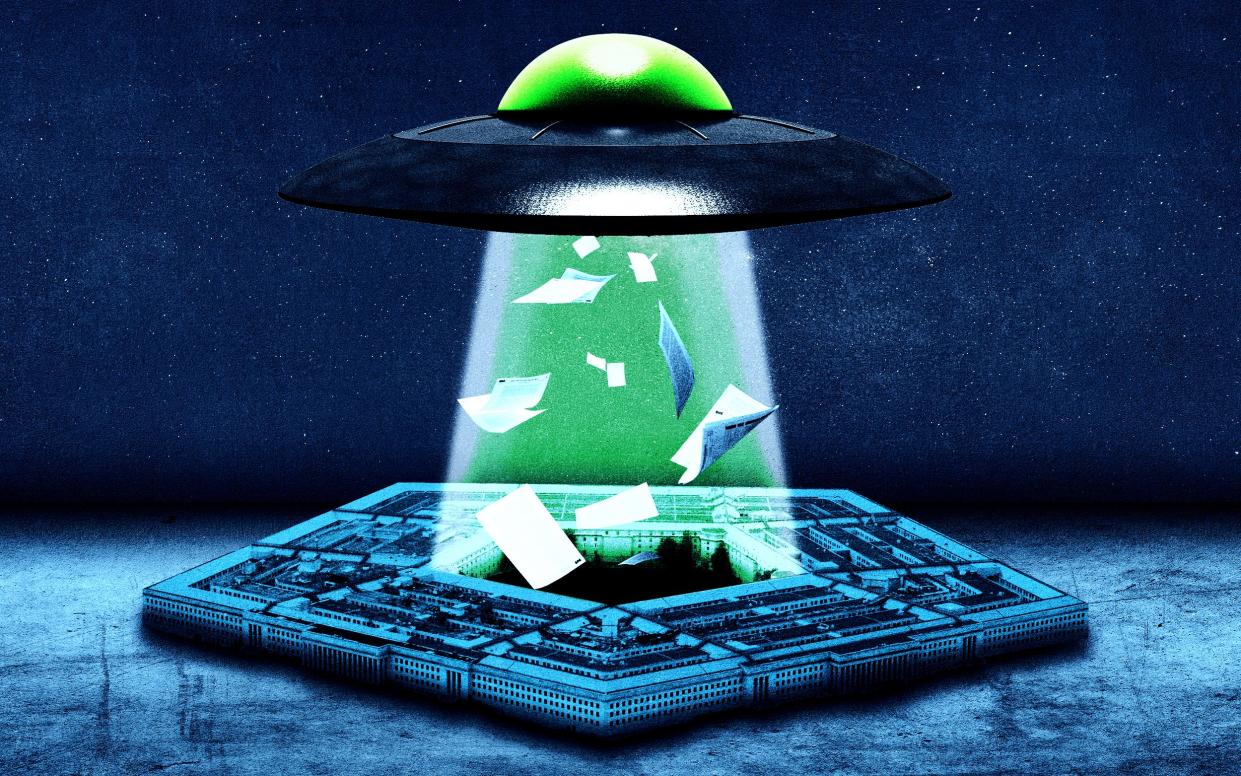Pentagon reveals all on UFOs but report finds no evidence of aliens visiting Earth

- Oops!Something went wrong.Please try again later.
A highly anticipated US intelligence report on UFO sightings concluded that the vast majority could not be explained.
It was unable to rule out the possibility that they were highly advanced aircraft operated by foreign adversaries, or that they were of extraterrestrial origin.
Pentagon researchers reviewed 144 sightings but said only one of them could be explained with confidence.
The report said UFOs could be a national security threat and that there was probably no single explanation for them, describing the results as "largely inconclusive".
It was concluded that, in many cases, they were real objects, having been picked up by multiple sensors in 80 of the 144 cases.
There was no definitive link to potential technology developed by China and Russia, but that was possible, the report said.
Long dismissed as the preserve of cranks and conspiracy theorists, the study of UFOs has been taken increasingly seriously recently by the Pentagon, which calls them unidentified aerial phenomena [UAPs].
The nine-page report was compiled by the Pentagon's UAP Task Force and delivered to the House and Senate Intelligence Committees by Joe Biden's Director of National Intelligence Avril Haines.
It was published online by her office but only senators will see a classified annex.
Conspiracy theorists will probably focus on what could be in the annex to the report.
The 144 sightings were reported by military personnel between 2004 and 2021, and the only one the Pentagon could fully explain was found to be a large, deflating balloon.
The report said: "Most of the UAPs reported probably do represent physical objects given that a majority of UAP were registered across multiple sensors.
"There are probably multiple types of UAP requiring different explanations."
It said the sightings could be in one of five "potential explanatory categories" - airborne clutter, natural atmospheric
phenomena, government or private industry research projects, foreign adversary systems, or "other".
In 11 cases pilots reported near misses with unidentified objects.
The report said: "UAP clearly pose a safety of flight issue and may pose a challenge to US national security. Safety concerns primarily centre on aviators contending with an increasingly cluttered air domain.
"UAP would also represent a national security challenge if they are foreign adversary collection platforms, or provide evidence a potential adversary has developed either a breakthrough or disruptive technology."
In 18 incidents military personnel reported seeing unusual flight movements by the objects.
"Some UAP appeared to remain stationary in winds aloft, move against the wind, manoeuvre abruptly, or move at considerable speed, without discernable means of propulsion," the report said.
It said there wasn't enough data to indicate any of the objects were part of a foreign spying programme.
The report said: "We continue to monitor for evidence of such programmes."
Asked about the possibility of extraterrestrial explanations a senior US official said: "That's not the purpose of the task force, to evaluate any sort of search for extraterrestrial life. That's not what we were charged with doing.
"Of the 144 reports we are dealing with here we have no clear indications that there is any non-terrestrial explanation for them. But we will go wherever the data takes us."
Another US official said: "The UAP we’ve documented demonstrate an array of aerial behaviours, which really emphasises the point that not all UAP are the same thing. There is not one single explanation for UAP.”
The report was requested by Marco Rubio, the Republican senator who is vice chairman of the Senate Intelligence Committee.
He has been alarmed by UFO sightings near US military facilities, and wants to establish whether China or Russia have made a technological leap in aircraft or drone technology.
Mr Rubio praised pilots who had come forward with sightings.
He said: "For years their concerns were often ignored and ridiculed. This report is an important first step in cataloguing these incidents, but it is just a first step.
"The Defence Department and intelligence community have a lot of work to do before we can actually understand whether these aerial threats present a serious national security concern."
There was no immediate reaction from China or Russia
Among the sightings the UAP Task Force looked into, and could not explain, was the so-called "Tic Tac" encounter.
In that incident several US Navy aviators saw what they described as a 40ft-long white oblong, which was also picked up on radar.
It happened when the aviators were operating from the USS Nimitz aircraft carrier off the California coast in 2004.
On the day the report was published one of them, retired US Navy Lieutenant Commander Alex Dietrich, said: "I don't consider myself a whistle blower. I don't identify as a UFO person. [But] we don't know what it was. The point was that it was weird, and we couldn't recognise it."
Leslie Kean, a US investigative journalist who pushed for disclosure of information by the Pentagon, told NBC: "I understand the report is going to declare these objects are not United States technology, that they’re not ours, and I think that is a really important statement."
Members of the Mutual UFO Network (MUFON), a civilian group which has investigated hundreds of thousands of UFO sightings since 1969, had also been waiting with bated breath for the report.
David McDonald, 74, MUFON's executive director and a veteran civilian pilot, told The Telegraph: "I always thought there would be disclosure (about UFOs) but I didn't expect to see it in my lifetime."
But he added: "I would caution against any true bombshells. I expect they'll fall back a bit on 'can neither confirm nor deny'."
Read more: Nick Pope: 'We don't know' isn't good enough – the US must find out what these sightings are

